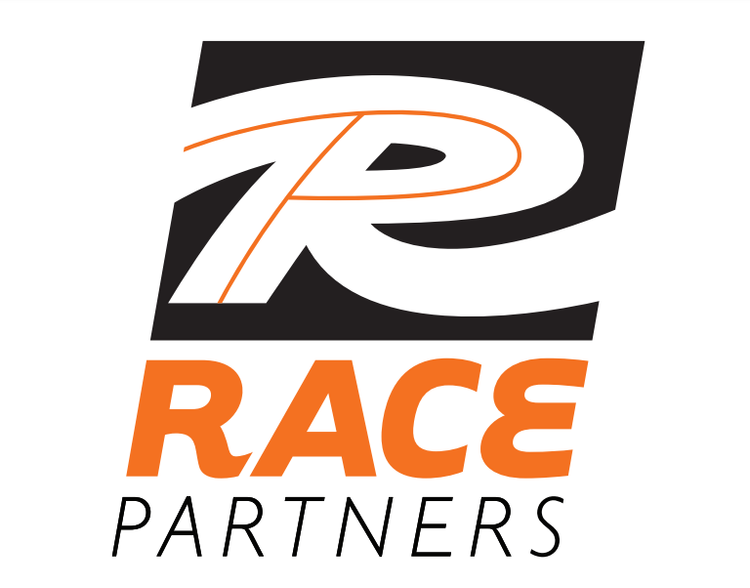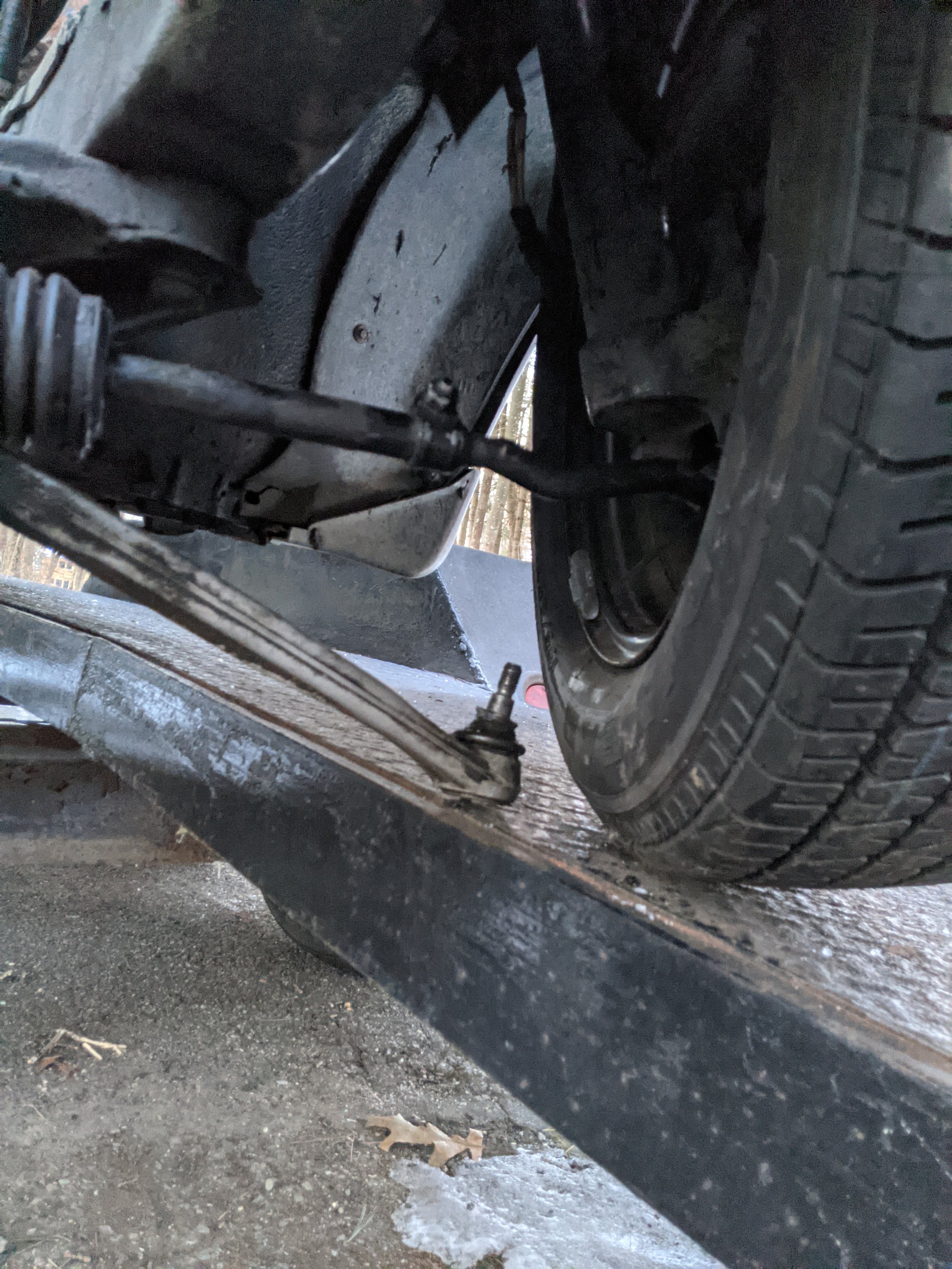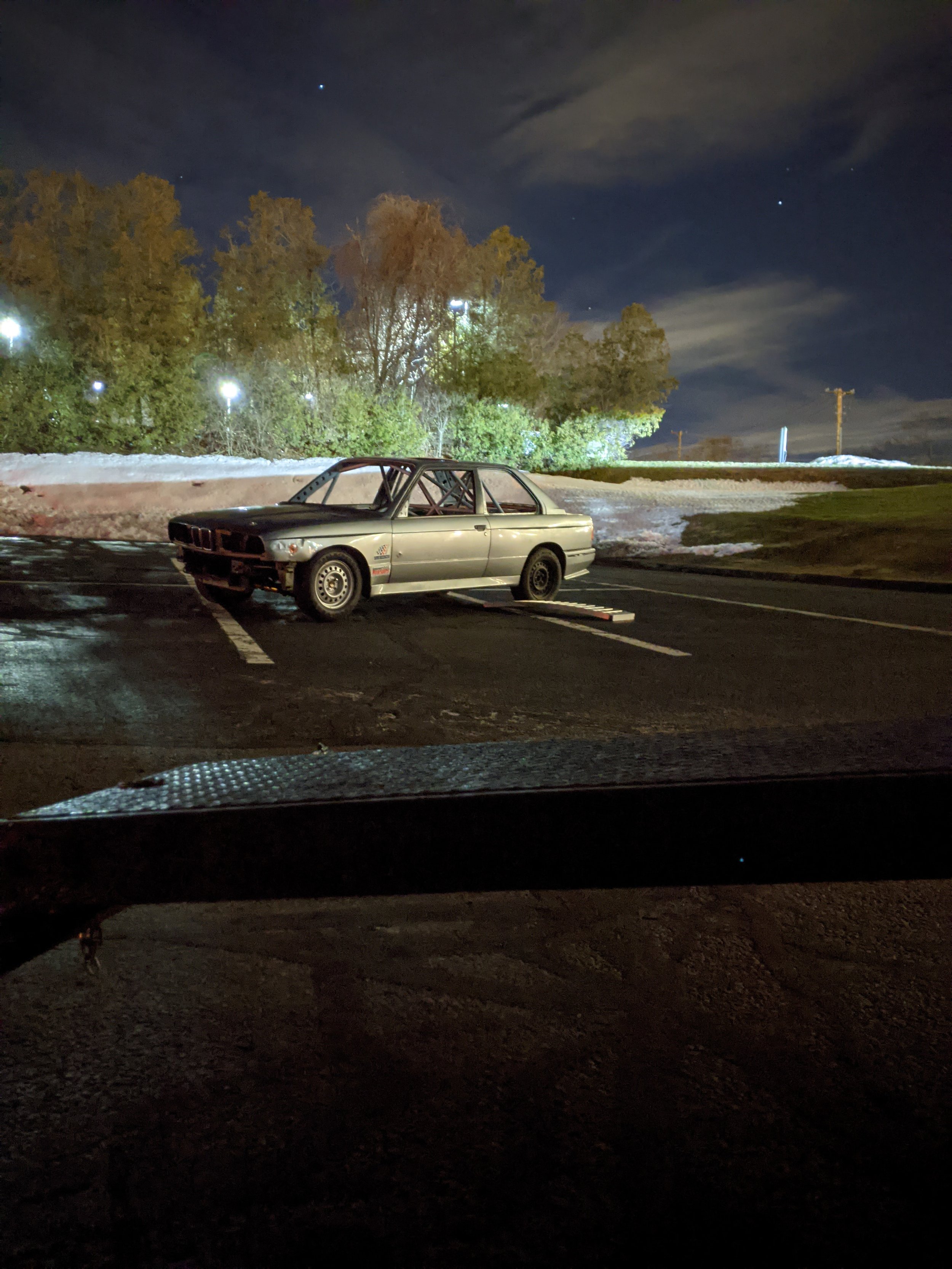The blog trails the project by almost two years (!) M3 Construction begins March 2021
Last we talked about the M3 I left the reader standing in a parking lot, 10pm on a March night. It was about 30f and we were waiting for what turned out to be a large Eastern European man in an even larger American pickup truck pulling a long, enclosed trailer.
After a few short phone calls we were lined up for the meet. I had my trailer. I was in my work parking lot because I was trying to make the driver’s life a little easier. There’s no place to turn around at my house and no room on our road to park so we chose this cold parking lot. I was missing a winch which would turn out to be a critical component to success.
The truck chugged in, a dualie diesel pickup with a 30ft trailer in-tow. Puffs of mist in the air from talking, hands shoved in pockets, it was a properly cold night. I was excited but the car even though I knew it wouldn’t be much to look at. He had to first unload a beautifully restored first-generation Bronco from the truck to access my car. The Bronco started easily, as one would expect. He carefully extracted the car and left it idling which was optimistic given our upcoming experience.
Like most sellers of things buyers buy there’s an asymmetric of knowledge and understanding between the buyer and seller. Usually the seller knows just a touch more and somehow that translates into profit, or more profit. This probably applies to almost all used car sales to ever happen. This new car of mine had M3 rear wheels (except steel) and M3 suspension but to get it rolling, the seller installed regular E30 front struts and spindles with 4 lug wheels. Ok, fine you say, no big deal. The problem we faced that night, in the parking lot, in the cold was that the seller didn’t consider using wrenches to fasten anything. There were two lug nuts on the floor of the trailer and several miscellaneous nuts from the control arms and tie rods rolling around with the lug nuts. As a result of this missing hardware, the tie rods had actually fallen out of the spindles and the wheels had turned 90 degrees out, inside the trailer, which was about 8” wider than the car on each side. It was also dark.
The next morning.
Luckily this man was hardened from years of dealing with shady sellers and optimistic, energetic buyers and he brought some good energy to the situation, helping me hold each wheel straight with every 4” roll backwards. They would flop out, hurting our hands, we’d lever them straight, roll a few more inches and repeat.
The car made it down the ramp of the enclosed trailer and was now sitting in the middle of the parking lot with a ramp jammed under the wheel, as if it were going to somehow roll away on it’s own. My new friend stood up straight to stretch his back and said, ok.. where is your winch?
Disappointment is sometimes easiest to digest by moving quickly back to the thing that brought you there in the first place. In this case I eagerly pulled the ramp from under the M3 and hooked it into my trailer and said “I didn’t think it would be too hard to push up” my man laughed. It couldn’t get worse. The Bronco idled away. He decided that we should back it onto my trailer from the parking lot and that made sense. Even if it didn’t make sense, I was so deeply in debt to this guy I would have agreed to anything. I actually don’t remember backing it on but I do remember using ratchet straps to walk it up the last bit, winching them inch by inch.
Once the car was up and strapped in, I stowed the original metal hood in the back of my 4runner and the accompanying carbon fiber hood, that stayed on the car. I gave him a tip and he asked me if he should wait. I think he was actually pretty satisfied that we pulled it all off. I thanked him and said no. He loaded the Bronco for a couple minutes and did a wide turn, disappearing from sight. My car was finally strapped down. (editor’s note: he later turned around and returned to check on me as I was driving away. How cool is that)
If the reader isn’t familiar with the hood latching strategy of an E30, it’s very unique and actually quite genius. The hood hinges at the front, not at the back. When it opens the nose pops forward and then pivots down, bowing to the onlookers, nosing down, then lifting vertically from the back. When you shut it, the windshield side of the hood is dropped onto two little guides and the the latch is at the front. The whole thing is captured deeply in the guides in the back, by the windshield. It’s all quite tidy. Oh, and it’s aided by a small hydraulic piston on the side with it’s own little hinge that makes it shut slowly and open easily. Why am I telling you all of this? Well, when I was in this parking lot, at now 11pm in 30ish-and-dropping temperatures I did not check that all of these beautiful components that aided in such a smooth and controlled hood shutting were all actually present.
It was officially late at night and with most things “car” or “meeting a person” I was tragically late to return home. I got there and simply parked the whole mess down by the barn “I’ll figure it out in the morning” There were lots of parts listed in my previous post stashed inside the shell, in bags and in boxes that would be investigated in the morning. As I went to bed I was pretty satisfied that it all worked out. These processes are long, from finding the shell, then getting the money together, to arranging transport, getting it home ; it was several months I think.
The next morning I unloaded the car after bolting the control arms in and re-affixing the tie rods. Wow it was much easier. I walked around it in the daylight, trying to assess the situation, build the project timeline in my head, trying not to stress. I unloaded the hood from the back of the 4Runner and brought it inside the barn. I went back out and looked again at the car. I went to pop the carbon hood to look at the empty engine bay except, one small issue, I could already see the empty engine bay! Apparently the nose of the hood was not bolted to the hinge mechanism and because the car was loaded backwards, the hood guides allowed the hood to slide forward and out of the guides, in this case due to the wind from the back of the car, thus making the hood into a giant carbon parachute with no ropes attached. O.M.G where was my hood? I did some mental mapping and realized I stopped at a light t just near work, then got on the highway. There was no traffic all the way home. (thankfully) The hood must have flown hundreds of feet, like a glorious carbon fiber kite because I did a recon run and it was nowhere to be seen. The only thing left to do was laugh.






